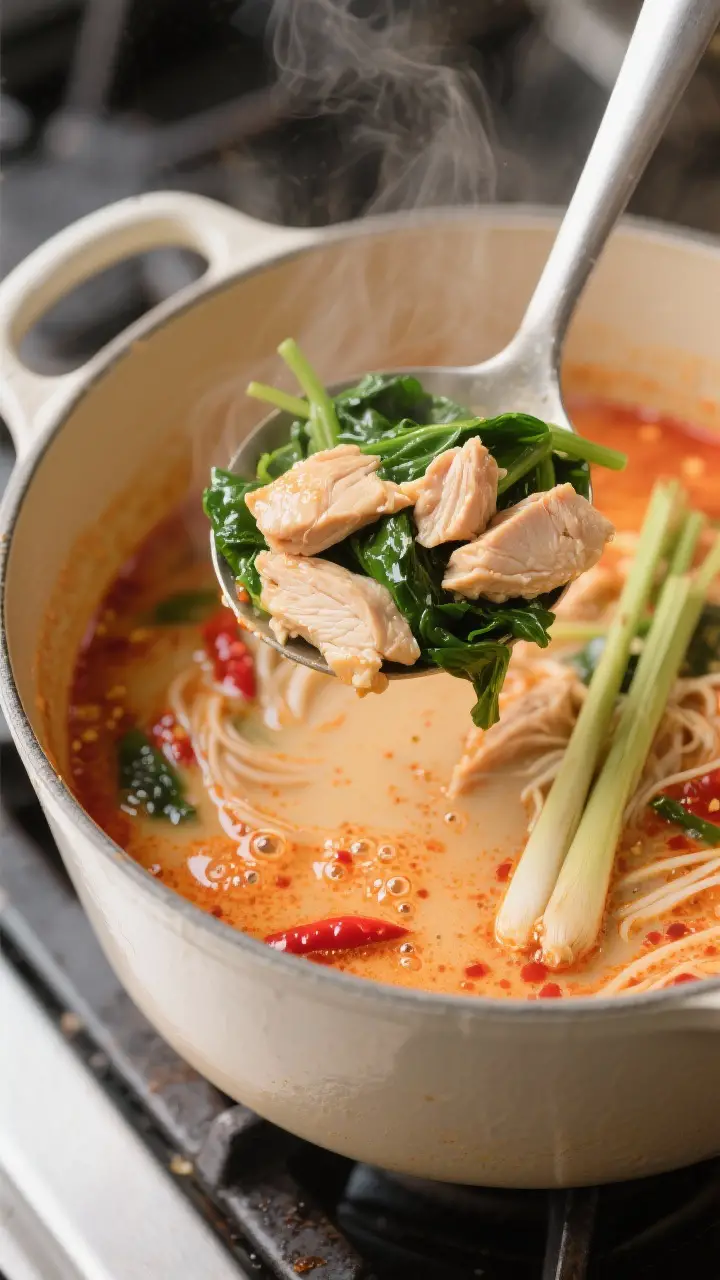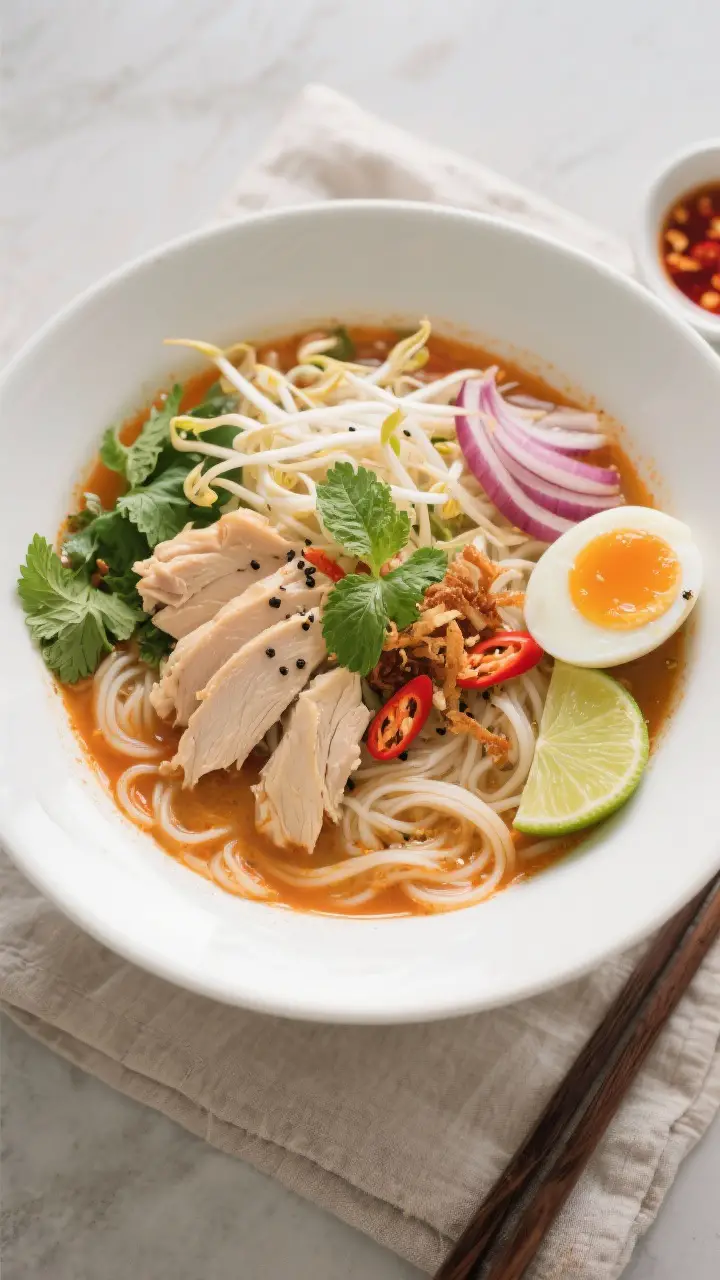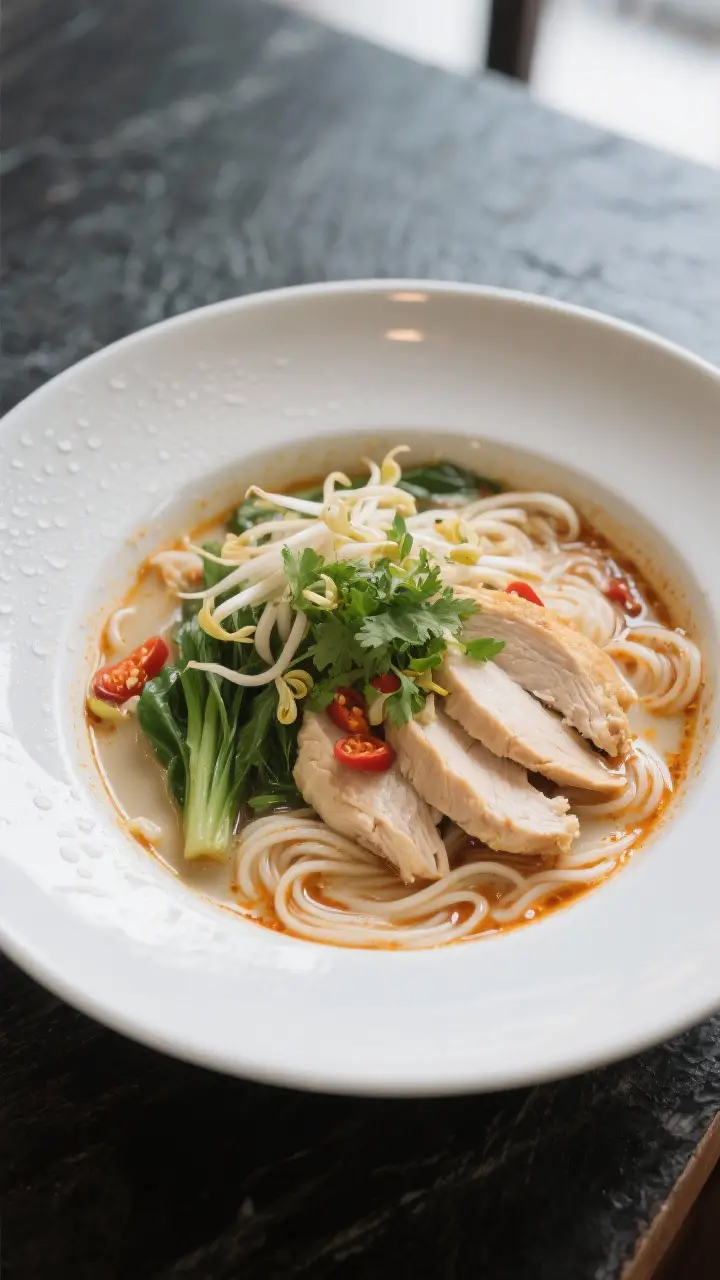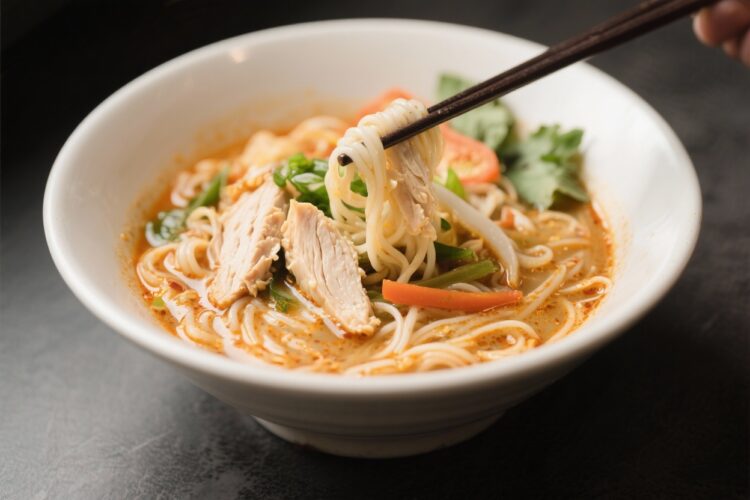Here’s the truth: most “quick dinners” taste like compromise. Chicken Laksa doesn’t. It’s a lightning-fast, flavor-bomb noodle soup that smells like you hired a personal chef.
Coconut, chili, lemongrass, and tender chicken collide into a broth so rich you’ll want to drink it like coffee. And the kicker? You can pull this off on a weeknight without crying over obscure ingredients.
Ready to eat like a millionaire with a grocery store budget?
What Makes This Recipe So Good

- Ridiculous flavor, minimal fuss: Laksa paste does the heavy lifting. You get complexity without culinary gymnastics.
- Texture party: Creamy coconut broth, bouncy noodles, silky chicken, crunchy bean sprouts—every bite hits different.
- Flexible and forgiving: Swap proteins, greens, or noodles based on what’s in the fridge. It still tastes elite.
- Fast turnaround: From fridge to bowl in about 30 minutes.
Faster than arguing over takeout.
- Restaurant vibes at home: Fragrant aromatics and fresh herbs make it look and taste fancy with minimal effort.
Ingredients Breakdown
- Coconut milk: Full-fat for body and richness. Light coconut milk will thin the broth (still fine, less lush).
- Chicken: Boneless, skinless thighs for juicy results; breasts work if sliced thin.
- Laksa paste: Store-bought is totally fine; look for Malaysian or Singaporean-style paste.
- Chicken stock: Low-sodium so you control salt. Homemade if you’re fancy.
- Lemongrass (optional but excellent): Lightly crushed stalk adds citrusy aroma.
- Ginger and garlic: Fresh, grated or minced for punch.
- Fish sauce: Salty umami depth.
Don’t skip unless vegetarian.
- Brown sugar or palm sugar: Balances heat and acidity.
- Lime juice: Brightens everything at the end.
- Cooking oil: Neutral oil for sautéing.
- Noodles: Rice vermicelli (thin) or thick rice noodles; cook separately to avoid mush.
- Vegetables: Bean sprouts, baby spinach or bok choy, and sliced red onion.
- Herbs: Fresh cilantro and mint; Thai basil if you have it.
- Chili: Fresh red chili or chili oil for extra heat.
- Toppings: Soft-boiled egg, crispy shallots, lime wedges.
- Salt and pepper: Season the chicken and adjust broth to taste.
Step-by-Step Instructions

- Prep the basics: Thinly slice 1 lb chicken thighs. Salt and pepper lightly. Boil water for noodles, then cook according to package and rinse with cold water to halt cooking.
- Heat aromatics: In a large pot or Dutch oven, add 1–2 tablespoons oil over medium heat.
Sauté 1 tablespoon grated ginger and 3 minced garlic cloves for 30 seconds until fragrant.
- Bloom the paste: Stir in 3–4 tablespoons laksa paste. Cook 1–2 minutes, stirring, until the oil turns red and it smells big and bold.
- Add liquids: Pour in 1 can (13.5–14 oz) full-fat coconut milk and 3 cups chicken stock. Add 1 lightly crushed lemongrass stalk if using.
Bring to a gentle simmer.
- Season the broth: Add 1 tablespoon fish sauce and 1–2 teaspoons brown sugar. Taste—adjust salt, fish sauce, or sugar to balance.
- Cook the chicken: Slide in the sliced chicken. Simmer 6–8 minutes until just cooked and tender.
Avoid a rolling boil to keep it juicy.
- Add greens: Stir in a big handful of spinach or sliced bok choy. Cook 1 minute until wilted. Remove lemongrass.
- Finish with acid: Kill the heat.
Stir in the juice of 1 lime. This wakes up the whole bowl.
- Assemble: Portion cooked noodles into bowls. Ladle hot laksa broth and chicken over the noodles.
- Top like you mean it: Add bean sprouts, red onion slices, fresh herbs, sliced chili, crispy shallots, and a soft-boiled egg if you’re going deluxe.
Serve with lime wedges.
How to Store
- Broth and noodles separately: Keep broth with chicken in one container and noodles in another. This prevents sad, soggy noodles.
- Fridge: Broth lasts 3–4 days in an airtight container. Noodles last 2–3 days.
- Freezer: Freeze broth (without greens if possible) for up to 2 months.
Thaw overnight in the fridge.
- Reheat: Warm broth gently on the stove until steaming; dunk noodles in hot water for 30 seconds to loosen, then assemble.

Health Benefits
- Protein-powered: Chicken provides complete protein to support muscle repair and satiety.
- Anti-inflammatory aromatics: Ginger, garlic, and chili bring antioxidants and digestion-friendly compounds.
- Smart fats: Coconut milk offers medium-chain triglycerides for quick energy—just keep portions balanced.
- Hydration and electrolytes: The broth helps rehydrate; fish sauce contributes trace minerals.
- Micronutrient boost: Herbs, sprouts, and greens add vitamin C, K, folate, and fiber. Your body says thanks.
What Not to Do
- Don’t overboil the chicken: High heat turns it rubbery. Gentle simmer = tender bites.
- Don’t cook noodles in the broth: They’ll release starch, cloud the soup, and over-thicken it.
- Don’t skip acidity: Without lime or a splash of vinegar, the flavor falls flat.
Acidity equals lift.
- Don’t go paste-happy without tasting: Some laksa pastes are spicy. Start moderate, adjust to avoid napalm-level heat.
- Don’t forget the toppings: Texture and freshness are half the magic. Bare bowls are fine, but why?
Variations You Can Try
- Prawn Laksa: Swap chicken for shrimp; simmer broth first, then poach shrimp for 2–3 minutes at the end.
- Tofu + Veg Laksa: Use firm tofu cubes, mushrooms, and extra greens.
Sub soy sauce for fish sauce to keep it vegetarian.
- Keto-ish Laksa: Replace noodles with shirataki or spiralized zucchini. Use extra chicken and veggies for volume.
- Roast Chicken Hack: Shred store-bought rotisserie chicken and add at the end to warm through. Weeknight win.
- Peanut Boost: Whisk in a tablespoon of peanut butter for a nutty, satay-like twist.
Not traditional, very tasty.
FAQ
Is laksa always spicy?
Usually it has a kick, but you control the heat. Use less paste, skip fresh chilies, and add more coconut milk if you need a gentler profile.
Can I use regular spaghetti instead of rice noodles?
You can, but expect a different texture and vibe. Rice noodles absorb the broth and feel lighter; spaghetti will be chewier and more dominant.
What if I can’t find laksa paste?
Mix red curry paste with a little curry powder, lemongrass, and chili paste as a stand-in.
It’s not the same, but it scratches the itch.
How do I make it dairy-free or gluten-free?
It’s naturally dairy-free thanks to coconut milk. For gluten-free, ensure your fish sauce and laksa paste are certified GF, and stick to rice noodles.
Can I meal prep this?
Yes—store the broth and noodles separately, then assemble just before eating. Add fresh herbs and sprouts right before serving so they stay crisp.
Why did my broth split?
Too high heat can cause coconut milk to separate.
Keep it at a gentle simmer and add acidic ingredients like lime at the end.
Which vegetables work best?
Bean sprouts, spinach, bok choy, snow peas, and sliced bell peppers all shine. Keep them crisp-tender for contrast.
My Take
Chicken Laksa is the cheat code for maximum flavor with minimum time investment. It’s bold, aromatic, and wildly customizable—perfect for nights when you want “special” without the drama.
If you’re new to Southeast Asian soups, this is a high-confidence entry point: low risk, huge reward. IMO, once you master the balance—spice, salt, sweetness, and acid—you’ll start riffing like a pro. And yes, the crispy shallots are non-negotiable.
Printable Recipe Card
Want just the essential recipe details without scrolling through the article? Get our printable recipe card with just the ingredients and instructions.

